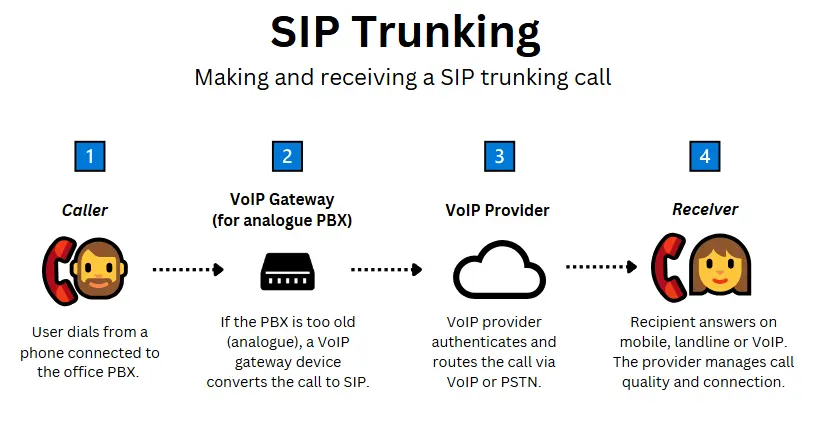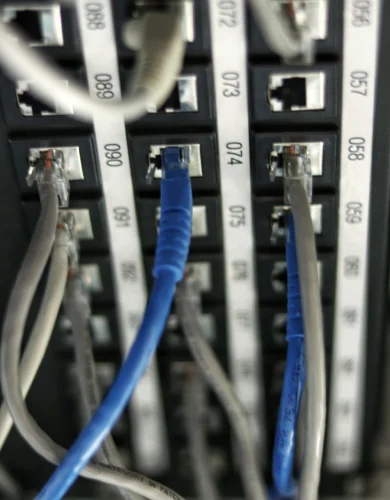SIP trunking for businesses
SIP trunking is a service that extends the life of legacy PSTN/ISDN business phone systems by adapting them to make and receive VoIP calls over the internet.
Many VoIP providers offer it to businesses that want to avoid a full overhaul of their phone systems, while still benefiting from VoIP’s lower rates and preparing for the upcoming PSTN Switch Off. This guide explains SIP trunking, how it works, how to set it up, and why it’s so important as traditional phone lines are phased out.
Contents
- What is SIP trunking?
- How does SIP trunking work?
- How to set up SIP trunking for your business
- SIP trunking features
- SIP Trunking in anticipation of PSTN & ISDN switch off
- SIP trunking vs PRI trunking
What is SIP trunking?
SIP trunking is a service offered by business VoIP providers that allows organisations to make and receive internet-based (VoIP) calls using their existing PBX (Private Branch Exchange) phone systems.
Many legacy PBX systems were sizeable investments, but they were designed for outdated copper business phone lines (i.e., ISDN or PSTN), which are now being phased out in the UK in favour of cheaper, more flexible VoIP technology.
SIP trunking bridges this gap by converting call signalling into SIP (a protocol used for managing internet-based calls) and routing them to their destination via the VoIP provider.
This means your business can continue using its existing PBX system and many of its core features, such as internal call routing and call forwarding. However, it won’t benefit from the full capabilities of modern cloud-based business VoIP phone systems, such as CRM integrations, remote VoIP access, UCaaS, or AI-driven tools.
💡 What is a PBX? A Private Branch Exchange (PBX) is a business phone system that routes calls between employees and handles incoming and outgoing calls to landlines and mobiles. Traditional PBXs run on physical hardware installed in your office, while VoIP PBXs are cloud-based.
How does SIP trunking work?

SIP trunking is a service that allows legacy business phone systems to make and receive calls over the Internet. It works by:
- Translating traditional phone signals from your PBX into SIP (Session Initiation Protocol)
- Routing those calls over the internet to and from the wider telephone network via your VoIP provider’s infrastructure
Here’s a step-by-step breakdown of how a SIP trunking phone call works:
1. Making a call from a traditional PSTN/ISDN phone
An employee dials a UK number using a desk phone connected to the business’s on-site PBX.
For older PBXs, this call is created using traditional telephony signalling (e.g. ISDN or analogue), which does not work over the internet.
2. Converting to SIP
The call must be converted into SIP (Session Initiation Protocol), the signalling protocol used to initiate, manage, and terminate VoIP calls.
Most modern PBX systems (typically post mid-2000s) have native SIP support and can handle the conversion. Older systems may require a VoIP gateway (a media or SIP gateway) to translate calls into SIP format.
Once converted, the call is effectively a VoIP call. However, these older PBX systems don’t have tools to route the call to its destination.
3. Routing the VoIP call
The SIP call is sent over your business broadband connection to your VoIP provider, a digital telecoms hub. The provider:
- Authenticates the call (verifies it comes from a valid user)
- Determines the destination number (e.g. landline, mobile, VoIP endpoint)
- Chooses the best path to deliver the call, either through the PSTN network (for traditional numbers) or over the VoIP network (if the recipient is also using VoIP.
The provider uses their infrastructure and carrier partners to deliver the call, capabilities your PBX system alone doesn’t have.
4. Recipient answers the VoIP call
Once the call reaches the recipient, two-way communication begins. SIP handles the call setup and teardown, while voice data is streamed using the RTP (Real-Time Transport Protocol).
The call may use compression codecs like G.711 or G.729 to optimise bandwidth.
When the call ends, SIP terminates the session cleanly. Your provider may log the call, update usage records, and provide analytics depending on your service plan.
Receiving a call via SIP trunking
Say the receiver calls you back at your business number (e.g. 020 or 0800).
Instead of going directly to your IP address, the call is first routed to your VoIP provider, who identifies the correct destination and sends the SIP call to your business broadband connection over the internet.
From there, it travels to your VoIP gateway or SIP-enabled PBX, which translates the call into the appropriate format and routes it to the correct extension or desk phone.
From the caller’s and receiver’s point of view, it feels just like a normal call. However, it’s now happening over the internet thanks to SIP trunking.
💡 Why ‘trunking’? In the telecoms industry, trunking refers to a system that carries multiple voice calls over a single connection, like how a tree trunk carries many branches.
How to set up SIP trunking for your business
Setting up SIP trunking isn’t overly complicated, but it’s not something you can switch on overnight. A few clear steps are involved, and it helps to know what to expect, especially if you’re working with a mix of legacy phone systems and modern broadband infrastructure.
1. Decide if SIP trunking is right for you
Before making any changes, assess whether SIP trunking fits your business well. It’s usually a smart choice if:
- You’ve already invested in a PBX system you don’t want to replace (yet)
- You want to switch from ISDN/PSTN before the 2027 Switch Off
- You’re a small business aiming to cut business VoIP costs or scale without a full cloud VoIP migration
- You don’t require advanced VoIP features like cloud integrations and AI tools.
2. Check your internet connection
SIP trunking depends on reliable, low-latency broadband to maintain call quality. If your connection is unstable or overloaded, VoIP call quality will suffer.
Here are the best business broadband options by scenario:
- Urban or full fibre areas: Leased line broadband with symmetrical speeds, low latency, guaranteed uptime and strong Service Level Agreements (SLAs).
- Rural or underserved areas: Ethernet-in-the-First-Mile or SoGEA with failover protection through broadband redundancy for added stability.
- Remote area: Business satellite broadband (e.g. Starlink) as a last resort, though it will be affected by latency and weather conditions. ADSL is usually insufficient for more than a single SIP line.
3. Prepare your network for SIP trunking
Your PBX must connect to the internet, so your LAN should be optimised for performance and VoIP security.
Network setup for call quality
- VLANs: Network switches with VLAN can separate VoIP traffic from general business traffic.
- Power-over-Ethernet (PoE): Simplifies power supply to VoIP phones and avoids cable clutter.
- QoS (Quality of Service): Configure your router or SD-WAN to prioritise SIP traffic and prevent call drops or jitter.
- Network segmentation: Keep guest WiFi and core business traffic separate to avoid interference with managing high VoIP traffic.
Network setup for secure SIP trunking
- Firewalls and routers: Allow only authorised SIP/RTP traffic; disable SIP ALG if it causes issues.
- Session Border Controller (SBC): Acts as a SIP firewall, protecting against call fraud and ensuring session integrity
- Encryption: Use TLS for SIP signalling and SRTP for voice data to safeguard conversations.
- Call fraud protection: Track outbound calls to detect unusual activity (e.g. international premium numbers).
- Compliance: Ensure your setup adheres to the Data Protection Act (GDPR) and any industry-specific data rules.
Essentially, it’s setting up your network for a VoIP installation.
4. Choose a VoIP provider that supports SIP trunking
Look for providers that offer:
- Number porting (to keep your existing UK landline or non-geographic numbers)
- Multiple SIP channels for concurrent calls
- UK-based support and transparent call plans
Not all VoIP providers support SIP trunking, so double-check their offering fits your setup.
5. Finalise your SIP trunking agreement
Once you’ve selected a provider, finalise your call plan, feature requirements, and SIP trunk capacity. Key elements may include:
- Number of SIP channels (simultaneous calls): Each SIP trunk supports multiple channels, one per simultaneous call. Most businesses only need one trunk, scaled to handle the number of calls required.
- Call recording: Automatically record inbound and outbound calls for training, compliance, or quality assurance (QA).
- Disaster recovery routing: Automatic failover to mobile or alternate numbers
- Fax over IP (FOIP): For fax support over SIP Trunking. Not fully reliable though, a dedicated fax-to-email service is best.
6. Edge cases: SIP trunking for VoIP phones
Contemporary VoIP phone systems don’t require SIP trunking because they natively support SIP, routing and security. Nevertheless, these systems remain compatible with SIP trunking to accommodate these niche use cases:
- To allow businesses migrating VoIP contracts to retain existing numbers easily.
- To get lower call rates in specific instances by routing calls via SIP trunk through a secondary provider.
- To use advanced routing or niche compliance controls for some specific calls.
SIP trunking features
Strictly speaking, SIP trunking doesn’t provide features; it’s the connection that allows your phone system (PBX) to make and receive calls over the internet.
The features you can access with SIP trunking depend entirely on the capabilities of your existing PBX system or VoIP-compatible phones.
- Call forwarding: Reroutes calls to mobiles or other numbers.
- Simultaneous ringing: Ring multiple phones or locations at once.
- Voicemail: Store and forward messages via your PBX.
- Call transfer & hold: Manage calls like a typical office phone system.
- Caller ID: Choose which number appears when dialling out.
💡 Advanced features: When using SIP trunking on modern VoIP phones (for special cases), you can get pretty much any of the latest VoIP integrations, including CRMs and ERPs, VoIP analytics, automated attendants and AI-powered call transcriptions.
SIP Trunking in anticipation of PSTN & ISDN switch off
The UK’s traditional phone infrastructure (PSTN and ISDN lines) is being phased out, with a national PSTN Switch Off now scheduled for 2027. This shift will affect all businesses still relying on copper-based phone lines.
To continue using a business phone service after the switch-off, you have two main options:
- Switch to a fully cloud-based VoIP phone system
- Adapt your existing PSTN/ISDN setup using SIP trunking
If your current PBX system still meets your needs and you don’t require advanced VoIP features like cloud integrations or AI tools, SIP trunking offers a practical, low-disruption alternative. It allows your business to:
- Extend the life of existing phone hardware
- Modernise communications gradually
- Lower ongoing telecoms costs
- Avoid service interruption when legacy lines are retired
SIP trunking vs PRI trunking
PRI (Primary Rate Interface) trunking is a legacy form of ISDN connectivity that allows multiple simultaneous calls over a single physical line, traditionally used in larger office phone systems.
Each PRI line typically supports 23 voice channels (30 in the UK using E1 standard) and was considered highly reliable for business telephony.
However, PRI is dependent on copper-based infrastructure and will be phased out as part of the Big Switch Off.
By contrast, SIP trunking uses your internet connection to enable voice calls through your existing PBX system. It also supports multiple simultaneous calls, but over the internet rather than a physical copper line. It is unaffected by the Big Switch Off.

